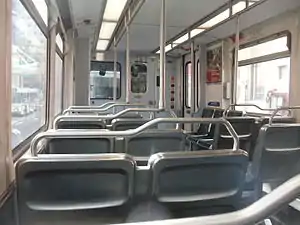Nippon Sharyo P865
The P865 was an articulated light rail vehicle used on the Los Angeles County Metro Rail system. It was manufactured by Nippon Sharyo and used on Metro's A Line and E Line.
| Nippon Sharyo P865 | |
|---|---|
 | |
 | |
| In service | 1990-2018 |
| Manufacturer | Nippon Sharyo |
| Constructed | 1987-1988 (Prototypes) 1989-1990 |
| Scrapped | 2017-2018 |
| Number built | 54 |
| Number preserved | 2 |
| Number scrapped | 52 |
| Successor | Kinkisharyo P3010 |
| Formation | Single unit |
| Fleet numbers | 100-153 |
| Capacity | 180 (76 seats) |
| Operator(s) | Los Angeles County Metropolitan Transportation Authority |
| Line(s) served | |
| Specifications | |
| Car body construction | Low alloy high tensile steel |
| Car length | 87 ft (26.52 m) Articulated car |
| Width | 8.7 ft (2.65 m) |
| Height | 11.6 ft (3.54 m) |
| Floor height | 39 inches |
| Doors | 8 (4 per side) |
| Wheel diameter | 2.4 ft (0.73 m) |
| Wheelbase | 6.2 ft (1.89 m) |
| Maximum speed | 55 mph (89 km/h) |
| Weight | 94,160 pounds (42,710 kg) |
| Train heating | Yes |
| Electric system(s) | 750 V DC Overhead line |
| Current collection method | Pantograph |
| Bogies | Inside-bearing type with resilient wheels (2 motored trucks + 1 non-powered center truck) |
| Braking system(s) | Pulse width controlled electro-pneumatic disc brake |
| Safety system(s) | Emergency brakes, ATP |
| Coupling system | Tomlinson |
| Track gauge | 4 ft 8 1⁄2 in (1,435 mm) standard gauge |
| Notes | |
| [1] | |
The trains featured air conditioning, emergency intercoms, wheelchair spaces and automated announcements. They are of an air-electric design, with air powered doors, friction brakes, and a pantograph.
Operational history
The P865s were the first urban rail vehicles to run in Los Angeles County since the Pacific Electric Railway ceased operations in 1965. The original 54 railcars, numbered 100-153, were ordered at a cost of $1.17 million each.[2] Prior to entering service, all of the railcars were christened after various cities in Los Angeles County; it was in the same style as christening a ship before being launched.[3][4] Examples include Long Beach (Car 100) and Bell (Car 105). They were retired on September 28th, 2018.
- Note: 39 prototypes were built from 1987-1988, they were revealed in November 1988 and made trial runs for a few months before the original P865s arrived in late October of 1989.
Nippon Sharyo P2020
| Nippon Sharyo P2020 | |
|---|---|
| In service | 1995-2021 |
| Manufacturer | Nippon Sharyo |
| Constructed | 1994-1995 |
| Number built | 15 |
| Number in service | 13 |
| Successor | Kinkisharyo P3010 |
| Formation | Single unit |
| Fleet numbers | 154-168 |
| Line(s) served | |
| Specifications | |
| Safety system(s) | ATC, CBTC, ATO (pre-2003), ATP |
The P2020 was the newer version of the P865, which had automated control panels for Green Line service since the Green Line was originally intended to be fully automated. A total of 15 vehicles with that model designation were delivered to Metro in 1994.[5] The railcars, numbered 154-168, entered revenue service on the Green Line the following year. In 2002, Cars 154-168 were transferred to the Blue Line fleet, when the Green Line received newer Siemens P2000 LRVs.
As of January 2021, the P2020s are scheduled to retire due to storage capacity at max from the final deliveries of the P3010. All 15 railcars will be retired and scrapped by March 2021.
Overhaul
In late 2013, Metro awarded a 60-month fixed price contract to ORX to overhaul the powered axle assemblies for the then twenty-three year old railcars.[6]
Retirement and preservation
The P865s were completely retired in September 2018 after 28 years of service, and were replaced by Kinkisharyo P3010s.[7] While most of the P865s were dismantled for parts and subsequently scrapped,[7] Cars 100 and 144 were retained. Car 100, christened Long Beach, is being preserved for its namesake city. Car 144 was donated to the Southern California Railway Museum in Perris, California. Both cars are currently preserved in operating condition.
The P2020s are expected to be towed to Division 16 in Westchester by March 2021 via the C Line. The fleet will be scrapped sometime after the division transfer.
In popular culture
The P865 has made several media appearances other than public service announcements. It was featured in movies such as Lethal Weapon 3, The Italian Job, and Captain Marvel.
References
- "LRV for LACMTA". Nippon Sharyo USA. Nippon Sharyo. Retrieved 8 March 2016.
- Ramberg, Anders (July 13, 1990). "Transit: Sleek New Blue Line Will Debut on Saturday". The Los Angeles Times. p. A22. Retrieved January 7, 2018 – via Newspapers.com.

- Ubaldo, Jose (2017-06-22). "The Metro Blue Line says hello/goodbye to new/old rail cars". The Source. Retrieved 2019-07-09.
- metrolibrarian (2008-04-18), (1990) "Metro Blue Line Grand Opening and Mobility Promo", retrieved 2019-07-09
- "Products". Nippon Sharyo USA. Nippon Sharyo. Retrieved 8 March 2016.
- "P865/P2020 Light Rail Vehicle Powered Axle Assembly Overhaul" (PDF). media.metro.net. LACMTA. Retrieved 8 March 2016.
- "End of an era: the last P865 light rail car has been decommissioned". The Source. 2018-09-28. Retrieved 2018-10-19.
External links
 Media related to LACMTA P865 at Wikimedia Commons
Media related to LACMTA P865 at Wikimedia Commons Media related to LACMTA P2020 at Wikimedia Commons
Media related to LACMTA P2020 at Wikimedia Commons